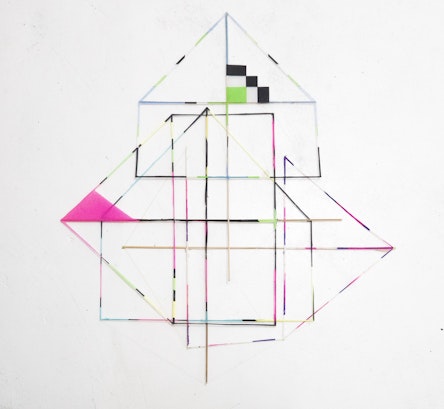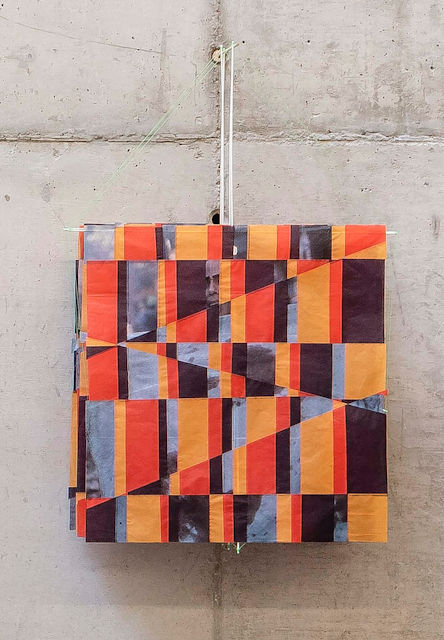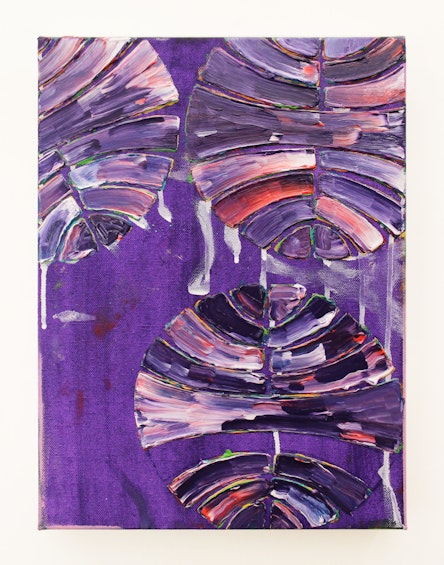
Verve presents a dialogue between two artists: Guilherme Callegari and Igor Vidor. With distinct approaches and deployments, both drink from the same source: everyday life and how it affects our perception of the world. Guilherme Callegari makes his compositions in painting from elements that convey symbols of consumer culture. There is an additional layer of meaning there: art as an archeology of the cultural habits of our time. In these works, there is no longer anything written: only typographic stains and color fields. By defunctionalizing the verbal language, the artist is therefore aestheticizing the designer's art: lines, voids, thickness, blocks of color and graphic stains.
Igor Vidor’s approach comes from the critical observation of Brazilian reality and its power institutions. His research focuses on the contemporary dynamics of violence, crime, power and resistance in Brazil, perpetuated since European colonization. In the series of works made with kite paper, Vidor makes a strong statement on the lives of so many children whose childhood is stolen by the militias on an everyday basis in the communities of Rio de Janeiro. The Esquema Series, made with gun bullets collected in these communities, is a critical revision on the Concretism and Neo-concretism movements, historically related to power elites from the southeast that still hold power in the Brazil's geopolitical dynamics. By presenting these two young artists' approach together, Verve brings a diverse panorama of contemporary Brazilian production, where the artworks can be read as living testimonial of turbulent and changing times in the country.
Born from the enthusiasm and inspiration that animates the spirit of artistic creation, Verve is home for distinct experimental platforms in contemporary art. Eloquence and subtlety are at the root of the term Verve, as well as in the careful selection of artists and program. By understanding that artistic languages comprise continuous and complementary processes, the gallery represents young and established artists in dialogue, who move freely between painting, performance, drawing, photography and sculpture. Directed by artist Allann Seabra and architect Ian Duarte, the gallery occupies a space in the historic Louvre Building, establishing an open dialogue with the built heritage of the city of São Paulo. From the exhibition space and its connection with urbanity, countless possibilities emerge, extending the gallery's reach to the streets and fulfilling the integrative function between art, the public and the city. Verve is a member of the Brazilian Association of Contemporary Art [ABACT] and is a member of the SP-Arte Advisory Committee.

Igor Vidor explores mechanisms of power and oppression through his sculptures, performances, and videos. His works convey signs of violence and social injustice deeply rooted in latin-american everyday life. The artist reflects how these conditions repeat themselves, perpetuating symbols of violence that end up taking on new meanings. He allows us to reflect on how this friction contributes to a scenario of intermittent and seemingly insoluble violence that finds echoes and recurrence in the history of Brazil. His work has been featured in numerous international exhibitions, including Berlinische Galeria (2021), Kunstlerhaus Bethanien (2020); Perez Art Museum Miami (2018), Mercosul Biennial (2018), Sesc 24 de Maio (2017), Museu Histórico Nacional, Rio de Janeiro (2017), Museu de Arte do Rio (2016). In 2016, he was the first Brazilian invited to participate in the International Exchange Program by the National Museum of Modern and Contemporary Art in Seoul - MMCA.

Igor Vidor explores mechanisms of power and oppression through his sculptures, performances, and videos. His works convey signs of violence and social injustice deeply rooted in latin-american everyday life. The artist reflects how these conditions repeat themselves, perpetuating symbols of violence that end up taking on new meanings. He allows us to reflect on how this friction contributes to a scenario of intermittent and seemingly insoluble violence that finds echoes and recurrence in the history of Brazil. His work has been featured in numerous international exhibitions, including Berlinische Galeria (2021), Kunstlerhaus Bethanien (2020); Perez Art Museum Miami (2018), Mercosul Biennial (2018), Sesc 24 de Maio (2017), Museu Histórico Nacional, Rio de Janeiro (2017), Museu de Arte do Rio (2016). In 2016, he was the first Brazilian invited to participate in the International Exchange Program by the National Museum of Modern and Contemporary Art in Seoul - MMCA.

Igor Vidor explores mechanisms of power and oppression through his sculptures, performances, and videos. His works convey signs of violence and social injustice deeply rooted in latin-american everyday life. The artist reflects how these conditions repeat themselves, perpetuating symbols of violence that end up taking on new meanings. He allows us to reflect on how this friction contributes to a scenario of intermittent and seemingly insoluble violence that finds echoes and recurrence in the history of Brazil. His work has been featured in numerous international exhibitions, including Berlinische Galeria (2021), Kunstlerhaus Bethanien (2020); Perez Art Museum Miami (2018), Mercosul Biennial (2018), Sesc 24 de Maio (2017), Museu Histórico Nacional, Rio de Janeiro (2017), Museu de Arte do Rio (2016). In 2016, he was the first Brazilian invited to participate in the International Exchange Program by the National Museum of Modern and Contemporary Art in Seoul - MMCA.

The duality that links correction to error is present in the work of Guilherme Callegari. His paintings are made up of several layers, overlaped without being completely covered, in a game of error and compositional correction. These are elements come from the graphic world, such as typography, logotype and calligraphy, all of which are emptied of their semantic meaning – or emblematic in the case of logos – used by the artist as a constructive form, creating color blocks in each composition - these are the artifices that Callegari uses in the creation of his paintings. There is no rule or precise material, the work takes place in the accumulation and superposition of different elements and materials, such as charcoal, acrylic, synthetic enamel, crayons, resin, among many others. Callegari has been awarded won at the Praia Grande and Santo André salons, participated in group exhibitions at BARÓ Galeria, Zipper Galeria, two solo exhibitions at Casa Nova Arte e Cultura Contemporânea, and one at Verve, in 2019. His works are part of private collections in São Paulo, Rio de Janeiro, Lima and Amsterdam, as well as the Public Collections of the Rio Art Museum-MAR (appointed by art critic Paulo Herkenhoff), Casa do Olhar Luiz Sacilotto (Santo André - SP) and Palácio das Artes (Praia Grande - SP).

The duality that links correction to error is present in the work of Guilherme Callegari. His paintings are made up of several layers, overlaped without being completely covered, in a game of error and compositional correction. These are elements come from the graphic world, such as typography, logotype and calligraphy, all of which are emptied of their semantic meaning – or emblematic in the case of logos – used by the artist as a constructive form, creating color blocks in each composition - these are the artifices that Callegari uses in the creation of his paintings. There is no rule or precise material, the work takes place in the accumulation and superposition of different elements and materials, such as charcoal, acrylic, synthetic enamel, crayons, resin, among many others. Callegari has been awarded won at the Praia Grande and Santo André salons, participated in group exhibitions at BARÓ Galeria, Zipper Galeria, two solo exhibitions at Casa Nova Arte e Cultura Contemporânea, and one at Verve, in 2019. His works are part of private collections in São Paulo, Rio de Janeiro, Lima and Amsterdam, as well as the Public Collections of the Rio Art Museum-MAR (appointed by art critic Paulo Herkenhoff), Casa do Olhar Luiz Sacilotto (Santo André - SP) and Palácio das Artes (Praia Grande - SP).

The duality that links correction to error is present in the work of Guilherme Callegari. His paintings are made up of several layers, overlaped without being completely covered, in a game of error and compositional correction. These are elements come from the graphic world, such as typography, logotype and calligraphy, all of which are emptied of their semantic meaning – or emblematic in the case of logos – used by the artist as a constructive form, creating color blocks in each composition - these are the artifices that Callegari uses in the creation of his paintings. There is no rule or precise material, the work takes place in the accumulation and superposition of different elements and materials, such as charcoal, acrylic, synthetic enamel, crayons, resin, among many others. Callegari has been awarded won at the Praia Grande and Santo André salons, participated in group exhibitions at BARÓ Galeria, Zipper Galeria, two solo exhibitions at Casa Nova Arte e Cultura Contemporânea, and one at Verve, in 2019. His works are part of private collections in São Paulo, Rio de Janeiro, Lima and Amsterdam, as well as the Public Collections of the Rio Art Museum-MAR (appointed by art critic Paulo Herkenhoff), Casa do Olhar Luiz Sacilotto (Santo André - SP) and Palácio das Artes (Praia Grande - SP).